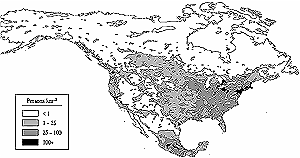15.2.4.2.3. Respiratory disorders
In 1997, approximately 107 million people in the United States lived in counties
that did not meet air quality standards for at least one regulated pollutant
(Patz et al., 2000). Climate change increases smog (NRC, 1991; Sillman
and Samson, 1995; USEPA, 1998a; Patz et al., 2000) and acidic deposition.
Climate change is likely to have a positive (worsening) effect on suspended
particulates (Maarouf and Smith, 1997). These changes would have an impact on
human health. However, at this time there are too few studies on the effect
climate change will have on all pollutants to project human health impacts.
Studies (Bates and Sitzo, 1987, 1989; Tseng et al., 1992; Burnett et
al., 1994; Delfino et al., 1994, 1997; Schwartz, 1994; Thurston et
al., 1994) have demonstrated that hospital admissions for respiratory illnesses
are increased during contemporary air pollution episodes, when levels of ozone,
acid aerosols, or particulates are elevated (Campbell et al., 1995).
Adaptive measures to changing pollution levels include federal legislation
and warnings for the general population and susceptible individuals (Patz et
al., 2000).
15.2.4.2.3.1. Smog
More than half of all Canadians live in areas in which ground-level ozone may
reach unacceptable levels during the summer months (Duncan et al., 1998).
Peak 1-hour concentrations during typical pollution episodes in the Windsor-Quebec
City corridor often reach 150 ppb. Windsor exceeds standards for ozone air quality
(82 ppb) 30 days yr-1 on average. In the Lower Fraser
Valley, ozone concentrations typically are in the 90-110 ppb range during
pollution episodes. In the Southern Atlantic region, peak hourly ozone concentrations
are in the 90-150 ppb range (Duncan et al., 1998).
|

Figure 15-2: North American population density (ESRI, 1998).
|
Two expert panels from the Canadian Smog Advisory Program
have listed a wide range of health effects of ground-level ozone at levels that
plausibly may occur in Canada. These effects include pulmonary inflammation,
pulmonary function decrements, airway hyper-reactivity, respiratory symptoms,
possible increased medication use and physician/emergency room visits among
individuals with heart or lung disease, reduced exercise capacity, increased
hospital admissions, and possible increased mortality (Stieb et al.,
1995). The panels conceptualized potential health effects of air pollution as
occurring in a logical "cascade" or "pyramid," ranging from
severe, uncommon events (e.g., death) to mild, common effects (e.g., eye, nose,
and throat irritation) and asymptomatic changes of unclear clinical significance
(e.g., small pulmonary function decrements and pulmonary inflammation) (American
Thoracic Society, 1985; Bates, 1992).
Healthy persons can demonstrate effects from ozone exposure when they have
an increased respiratory rate (e.g., when they are involved in strenuous activities
outdoors) (Brauer et al., 1996). Ozone may pose a particular health threat,
however, to those who already suffer from respiratory problems such as asthma,
emphysema, or chronic bronchitis (Stieb et al., 1996). These three conditions
affect about 7.5% of the Canadian population (Ontario Lung Association, 1991).
Ozone also may pose a health threat to young, elderly, and cardiovascular patients
(Duncan et al., 1998). An increase in smog also would pose a greater
risk to African Americans, who have consistently higher rates of deaths and
emergency room visits than caucasians (Mannino et al., 1998).
15.2.4.2.3.2. Acidic deposition
Acidic aerosols—such as sulfur dioxide (SO2), sulfates, and
nitrogen dioxide (NO2)—have a colloidal affinity to fine particulates,
which provide the vector needed to penetrate deeply into the distal lung and
airspaces. In general, NO2 and SO2 have acute negative
impacts on the respiratory system (Campbell et al., 1995).
Several studies (Bates and Sitzo, 1987, 1989; Tseng et al., 1992; Burnett
et al., 1994; Delfino et al., 1994; Schwartz, 1994; Thurston et
al., 1994) have demonstrated that hospital admissions for respiratory illnesses
increase during contemporary air pollution episodes when levels of ozone, acid
aerosols, or particulates are elevated (Campbell et al., 1995). A study
by Raizenne et al. (1996) that examined the health effects of acid aerosols
on children living in 24 communities in the United States and Canada found that
long-term exposure had a deleterious effect on lung growth, development, and
function. Dockery et al. (1996) found that children living in communities
with the highest levels of strong particle acidity were significantly more likely
to report at least one episode of bronchitis in the past year compared to children
living in the least polluted communities.
|